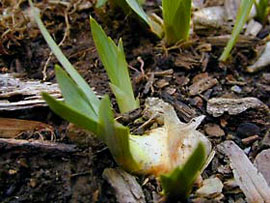Thanks to everyone for your many and varied gardening questions, some of which became full articles in this newsletter. By and large, I've included general questions in this column to catch the broadest reader interest, but I've appreciated all your questions, your patience in awaiting my reply, and your confidence in my gardening expertise. Please continue to ask me questions!

Narrow-leaf zinnia is an easy-care, heat-tolerant variety that grows well in containers.
Question: My container zinnias were colorful and longlasting, but marred by what I think was powdery mildew. What is the best treatment for this?
Answer: Resistant varieties and good air circulation are the best ways to avoid powdery mildew. Watering in the morning helps to reduce powdery mildew. Once the disease is prevalent, fungicidal sprays help to eliminate it. It is also wise to get rid of powdery mildew-prone plants, like certain varieties of bee balm, aster, and goldenrod.
Question: All summer my basil grew beautifully in a pot on my porch. As soon as the temperature plunged to 40 degrees, I moved the pot inside. The plant flowered and now the leaves are brown and failing off. Can I save the plant?
Answer: With high-powered lights and lots of care you could get the basil to survive, but not thrive. Basil thrives under bright summer sun. As days shorten in fall (or you bring plants inside), these annuals flower, seed, and then senesce. The best way to "save" your plant is to collect some seeds and sow them next year.
Question: I have a small garden at my Montessori school in Tacoma. We have some straw left over from Halloween decorating and I remember seeing straw put on gardens in the fall, but I do not know why, how, for how long, etc. Can you help me out?
Answer: Straw is an excellent organic mulch and this will make a teachable moment for kids about recycling and repurposing resources. Either spread a thin layer and turn it into the soil in spring as an amendment, or layer it thickly and simply remove the straw before planting in spring. If you have rodent problems, spread thinly to avoid nesting.

Cut back iris foliage before winter.
Question: How should I ready my irises for winter? The rhizomes are covered with mulch. Should I brush it back? The leaves are still very healthy. Should I trim them? They'll die back if I don't. Is that sufficient?
Answer: It is always best to trim iris foliage. I just lost a stand of purple and white reblooming irises to iris borers. These pests burrow in the foliage during the autumn and feed on the rhizomes. Trimming the leaves typically removes any eggs, or at least exposes borer holes.
As far as the mulch, most books recommend removing it and exposing the rhizomes. But in practice, irises perform just as well when covered.
Question: What's the best way to "root" a clematis vine? I tried the water-in-jar and soil methods, both with disappointing results. I don't know what variety this clematis is — it mysteriously appeared on a chain-link fence in my yard.
Answer: Most clematis do not root easily. You could try layering a branch next spring, like you would a shrub. But the easiest way to propagate clematis is to sow seeds. That's probably how your mystery clematis arrived in the first place.
Question: I would appreciate advice on how to prune my Henry Lauder's Walking Stick. Some parts of the shrub seem to grow really fast — should I trim the top branches to control it better?
Answer: Henry Lauder's Walking Stick is a fun, twisty shrub that is more interesting than beautiful. The trick to growing this plant is to remove all suckers, which grow straight from the roots and do not have the twisting growth habit. Those suckers can quickly overwhelm the ornamental aspects of the shrub. Winter is a great time to prune all shrubs, especially Henry Lauder's Walking Stick, because you can clearly see all the branches and easily remove the suckers.